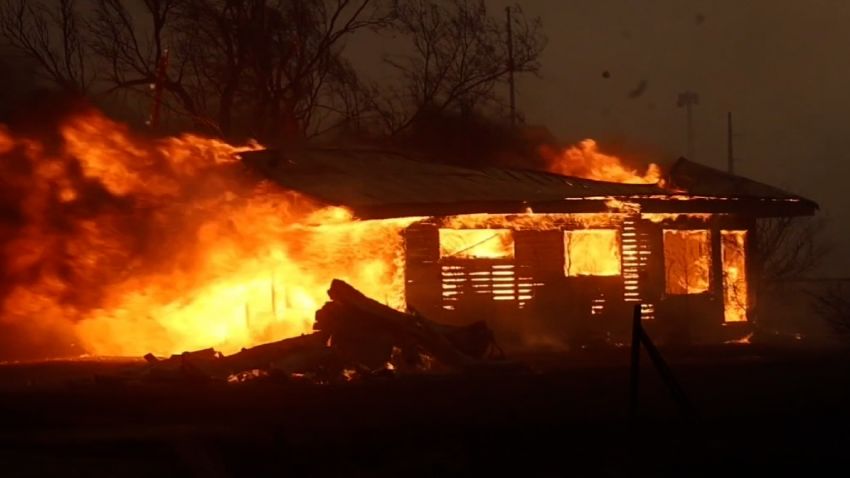Unprecedented wildfires have engulfed the Texas Panhandle, leading to a significant evacuation of residents across the region. The wildfire, named the “Smoke House Creek Fire,” began its destructive path on February 24. Since then, it has caused extensive damage, consuming an estimated 850,000 acres and still spreading.
The rapid spread of the Smoke House Creek Fire has led to numerous evacuations, with residents in several counties being advised to vacate their homes for safety reasons. The fire’s relentless progression has posed considerable challenges for the firefighters attempting to contain it.
In response to the escalating situation, road closures have been implemented, including a section of Interstate 20. This has resulted in significant disruption to traffic and travel within the region, adding to the already mounting crisis.
Texas Wildfires: A State in Crisis
The Texas A&M Forest Service, tasked with overseeing efforts to extinguish the fire, has reported that only approximately 30% of the fire has been contained so far. The battle against the these wildfires has been complicated by strong winds and dry conditions, which have fueled the devastating growth of the fire.
Governor Greg Abbott has declared a state of disaster in seven counties in response to the Texas wildfires. This urgent declaration will enable these areas to access additional resources and support to manage the ongoing crisis. The state of disaster underscores the severity of the situation and the need for immediate response.
While the cause of the Smoke House Creek Fire remains under investigation, this Texas wildfire serves as a stark reminder of the dangers posed by wildfires and the importance of preparedness and response measures in mitigating their impact.
The Human Impact: Evacuations and Disruptions
The Texas Panhandle fires have necessitated widespread evacuations, affecting thousands of residents. The scale of the evacuation highlights the severity of the situation and the urgency required in response. The safety of residents is the top priority, with authorities working tirelessly to manage the evacuation process.
Road closures, including a major section of Interstate 20, have significantly disrupted traffic and travel in the region. These closures, while necessary to ensure public safety and facilitate firefighting efforts, have added another layer of complexity to the crisis caused by the Texas wildfires.
The Texas wildfires have not only disrupted lives but also caused extensive damage to property. Homes, businesses, and infrastructure have all been affected, with the full extent of the damage yet to be determined.
Firefighting Efforts: Challenges and Progress
Firefighters are grappling with the formidable task of containing the Eastland Complex fire. The Texas Panhandle wildfires, fueled by dry conditions and strong winds, have proved difficult to control. Despite these challenges, firefighters continue their relentless efforts, displaying courage and determination in the face of adversity.
The Texas A&M Forest Service has reported that around 30% of the fire has been contained so far. This figure, while indicative of progress, also underscores the magnitude of the task at hand in battling the Texas wildfires.
The firefighting efforts have been bolstered by the state of disaster declaration by Governor Greg Abbott. This allows for additional resources and support to be directed towards combating the Texas wildfires, aiding the firefighting efforts and hopefully leading to more significant progress in containment.
State Response: Disaster Declarations and Support
In response to the Texas wildfires, Governor Greg Abbott has declared a state of disaster in sixty counties. This declaration reflects the severity of the situation and paves the way for these areas to access additional resources and support.
The state of disaster declaration enables funding and resources to be directed towards firefighting efforts, evacuation support, and eventual recovery and rebuilding once the Texas wildfires are under control. It also facilitates coordination between different levels of government and agencies, crucial in managing a crisis of this magnitude.
The state’s response to the Texas wildfires is not limited to immediate firefighting and evacuation efforts. Plans are being developed for recovery and rebuilding once the fires are under control. These plans will be critical in helping the affected communities recover from this devastating event.
Looking Forward: Lessons from the Smoke House Creek Wildfires
While the cause of the Smoke House Creek fire is still under investigation, the Texas wildfires serve as a stark reminder of the dangers posed by wildfires. The lessons learned from this event will be crucial in shaping future preparedness and response strategies.
The Texas wildfires have highlighted the importance of early detection, swift evacuation procedures, and effective firefighting strategies. Improving these areas will be key in mitigating the impact of future wildfires.
Final Thought
In conclusion, the Texas Panhandle is grappling with a major wildfire outbreak that has led to extensive evacuations, property damage, and a state of disaster. Efforts are underway to contain the fire and provide support to those affected, but the situation remains challenging. As the state continues to battle these devastating wildfires, the resilience and spirit of Texas remain undeterred.




